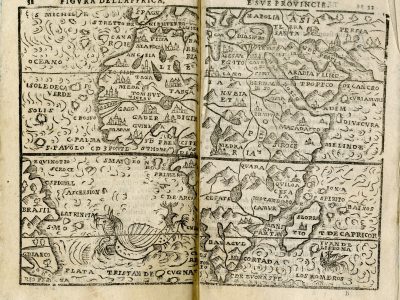
Figura dell’Affrica e sue provincie
Giuseppe Rosaccio, Teatro del cielo e della terra, 1598
Title of the volume: Teatro del cielo e della terra, nel quale si discorre breuemente del centro, e doue sia. Del terremoto, e sue cause. De’ fiumi, e loro proprietà. De’ metalli, e loro origine. Del mondo, e le sue parti. Dell’acqua, e sua salsedine. … Opera curiosa, & degna d’ogni eleuato spirito (Theatre of the Sky and of the Earth, in which there is a brief discussion of the center of the world and its location; of earthquakes and their causes; of rivers and their properties; of metals and their origin; of the world and its parts; of water and its salinity… A curious work, worthy of every elevated spirit)
Date: 1598
Author: Giuseppe Rosaccio (ca. 1530–1621)
Engravers: Giuseppe Rosaccio (ca. 1530–1621) (?)
Printer: Domenico Farri (1519–1604)
Publisher and place of publication: Domenico Farri, Venice
Plate execution tecnique: Woodcut
Language: Italian
Location: Geography Library, Morbiato Collection, MORB.3
Notes on the volume: The multifaceted intellectual Giuseppe Rosaccio studied Philosophy and Medicine at the University of Padua, later practicing medicine. At the same time, he worked as a cartographer and wrote voyage accounts. Among his most successful publications are Il Mondo e sue Parti, cioè Europa, Affrica, Asia, et America (The World and its Parts, namely Europe, Africa, Asia, and America, 1595), Le se ietà del mondo (The Six Ages of the World, 1595), and Viaggio da Venetia a Costantinopoli per mare, e per terra, e insieme quello di Terra Santa (Journey from Venice to Constantinople by Sea and by Land, and also to the Holy Land, 1598), published in Venice by Giacomo Franco and rich in engravings depicting city views and ports.
Teatro del cielo e della terra was first published in Brescia in 1592, but the more well-known edition is the Venetian one from 1595. It consisted of 56 pages, which increased in number over time and through the many later editions, eventually exceeding 160 pages around the mid-17th century. Rosaccio describes the structure of the heavens and spheres based on the Ptolemaic model. Concerning Earth, he describes America, Asia, Europe, and Africa, to which he adds a “southern unknown land.” Other pages are dedicated to explaining specific phenomena, such as earthquakes and the origin of metals.
GEO-CARTOGRAPHIC DATA
Scale: 1:6,400,000
Graphic scale: –
Orientation: North at the top
Size: 16.5 x 12.5 cm
Descriptive notes: The representation of the African continent includes some Atlantic Ocean islands, among which is one of the earliest appearances of “Tristan de Cugna” (modern Tristan da Cunha), the result of the growing body of geographical knowledge acquired through more than a century of exploratory voyages. Rosaccio closely follows Ortelius’s model, though there are some differences in the hydrography; for example, from the westernmost of the two lakes that form the Nile’s sources, only one river flows southward, rather than two as was customary. The toponyms also follow those proposed by Ortelius, but due to the map’s small size, fewer names are included.
Reliefs are represented using the so-called “molehill” technique, typical of the time. The continent of Africa is divided into the regions of Guinea, Barbary, Nubia, and “Egypt.” Major cities are marked with stylized building symbols. One such city appears on an island within a lake along the course of the Niger River, the only river shown in the Sahel, whose source is depicted as a lake and a city south of Nubia. The river flows westward and reaches the Atlantic, splitting into several branches at its mouth. The presence of a lake with a built-up island reappears in many African maps of the 16th and 17th centuries, echoing the model proposed by Giacomo Gastaldi in The Map of the Modern Geography of All of Africa (1564).
The map is embellished with a large sea monster in the Atlantic Ocean and a small boat in the Indian Ocean. This map appears in all the numerous editions of Teatro del cielo e della terra and Il mondo e sue parti published until the end of the 17th century.
Bibliography
Bono S. (1965). L’Africa nel “Mondo elementare e celeste” di Giuseppe Rosaccio, Africa: Rivista trimestrale di studi e documentazione dell’Istituto italiano per l’Africa e l’Oriente, 20/2: 192-194.
Casali E. (2017). Rosaccio, Giuseppe. In: Dizionario biografico degli italiani. Vol. 88, Roma: Treccani.
Rizzo G.J. (2006).The Patterns and Meaning of a Great Lake in West Africa. Imago Mundi: 83/84.